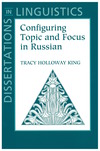

|
|
|
|

Configuring Topic and Focus in RussianThis book discusses the syntactic structure of Russian, traditionally thought of as a ‘free’ word order language in which word order reflects discourse functions, Tracy Holloway King argues that Russian is a configurational language, but that the expected orderings reflect different structures. With an in-depth sytactic analysis of a free wod order language, King discusses the syntactic representation of discouse functions. The first part of the book presents this topic using Government-Binding Theory, while the second presents the topic employing Lexical-Functional Grammar. Specifically, King proposes a tripartite division among topical-ized, focused, and discourse-neutral material and defines several types of topic and focus. Her distinctions are motivated by the different syntactic and phonological, as well as semantic, reflexes of the interpretation assigned to a constituent. Specific phrase structure positions act as lisceners for discourse functions: in order for a constituent to be interpreted as having a particular discourse function, it must appear in the appropriate position. Since the word order of a clause is derivative from the phrase structure, the motivated occurence of constituents in these posisitions results in the desired orderings and interpretations, without resorting to scrambling or stylistic PF reorderings. Ultimately, King suggests that this type of analysis can be extended to other free word order languages. is a research associate at Xerox Palo Alto Research Center. Contents
1/1/95 ISBN (Paperback): 1881526623 (9781881526629)
Subject: Linguistics; Russian Language--Word Order; Russian Language--Topic and Comment |
Distributed by the
University of Chicago Press |
|
pubs @ csli.stanford.edu
|
CSLI Publications
Stanford University Cordura Hall 210 Panama Street Stanford, CA 94305-4101 (650) 723-1839 |